Unveiling the World of Chilopoda and Diplopoda: Centipedes and Millipedes in Nature's Spotlight
Unraveling the mysterious world of Chilopoda and Diplopoda! Discover the unique traits of centipedes and millipedes, the predatory hunters and gentle detritivores, respectively. Explore their evolutionary history and ecological roles.

Chilopoda and Diplopoda, two fascinating classes within the subphylum Myriapoda, are home to some of the most intriguing arthropods found on our planet. Although often confused due to their similar appearances and numerous legs, centipedes, and millipedes represent distinct branches of the arthropod family tree, each with its unique characteristics, behaviors, and ecological roles.
Chilopoda, commonly known as centipedes, are predatory arthropods with a fierce reputation as skilled hunters. They possess elongated, segmented bodies, featuring one pair of legs per body segment. Despite their name, centipedes rarely have precisely one hundred legs; the count may range from 30 to 354, depending on the species. Armed with venomous fangs, centipedes use their toxic bite to subdue their prey, which typically includes insects, spiders, and other small invertebrates. Centipedes are predominantly nocturnal creatures, preferring dark and damp habitats, such as leaf litter, under logs, and inside soil crevices. Their extraordinary speed and agility aid them in catching swift prey, making them an essential part of the ecosystem by controlling insect populations.
On the other hand, Diplopoda, or millipedes, exhibit a more docile and herbivorous nature compared to their centipede counterparts. These arthropods have elongated cylindrical bodies composed of numerous segments, each housing two pairs of legs, except for the first three segments which have one pair each. Millipedes are renowned for their fascinating defensive behavior, often curling into a tight spiral when threatened and releasing chemicals that deter potential predators. These chemicals can vary from species to species, but they generally serve as a protective mechanism. Millipedes primarily feed on decaying plant matter, playing a crucial role in nutrient recycling within forest ecosystems. Due to their role as detritivores, millipedes contribute to enriching the soil by breaking down organic matter, making essential nutrients available to plants.
Both Chilopoda and Diplopoda have existed on Earth for millions of years, with fossils dating back to the Paleozoic era. Their evolutionary history and ecological adaptations provide valuable insights into the dynamics of ancient ecosystems and how life has thrived and evolved.
Chilopoda
- Phylum Arthropoda includes this group Chilopoda.
- Chilopoda includes centipedes.
- These are dorso - ventrally flattened, distinctly segmented arthropods.
- The body shows 2 divisions. 1. head and 2. long trunk.
- The head bears a pair of long, many-jointed, sensory antennae, a pair of eyes, a pair of toothed mandibles, and two pairs of maxillae.
- The mouth lies on the ventral side near the anterior border of the head.
- The trunk contains 15-173 segments in different species.
- Each segment has a flat tergum on the dorsal side and sternum on the ventral side.
- Each trunk segment, except the last two, bears on its lateral sides a pair of legs. They are modified into stout poison claws or maxillipeds. They are used for killing the prey.
- The anus is situated at the end of the trunk.
- There is a single genital opening.
- The genital opening opens in front of the anus on the ventral side of the penultimate segment.
- A pair of long Malphighian take up excretion.
- Tracheae serve as respiratory organs.
- Sexes are separate, there is a single gonad above the alimentary canal. E.g.: Scolopendra.
Diplopoda
- Phylum Arthropoda includes this class.
- The class Diplopoda includes the millipedes,
- These are long, cylindrical, segmented arthropods.
- The body has 3 divisions, head, thorax, and abdomen.
- The head bears a pair of short, 7 jointed antennae, a pair of eyes, a pair of mandibles, and a pair of maxillae.
- The maxillae are fused with the first thoracic sternum to form a large labium-like structure called the Ganthochilarium.
- The mouth lies between the mandibles.
- The thorax is short and consists of four single segments.
- Each segment has an arched tergum and a small flat sternum.
- The abdomen is long and comprises 20 to 103 segments.
- Each segment bears two pairs of 7 jointed legs.
- The third abdominal segment bears in the male a pair of short gonads or auxiliary compulsatory organs.
- Two genital apertures open out towards the anterior end on the third segment close to the second pair of legs (Progoneata).
- A pair of long malphighian tubules take up excretion.
- Tracheae will serve as respiratory organs.
- Sexes are separate. E.g.: Julus.
Conclusion
In conclusion, Chilopoda and Diplopoda, encompassing centipedes and millipedes, respectively, are captivating members of the arthropod family, each making distinct contributions to the biodiversity and ecological balance of our planet. Their roles as predators and detritivores highlight the significance of these enigmatic creatures in maintaining the delicate harmony of nature's web. Understanding and appreciating these remarkable arthropods offer us a glimpse into the marvels of the natural world and the wonders of evolution that have shaped life's diversity over eons.
The information on this page is peer reviewed by a qualified editorial review board member. Learn more about us and our editorial process.
Last reviewed on .
Article history
- Latest version
Cite this page:
- Comment
- Posted by Dayyal Dungrela